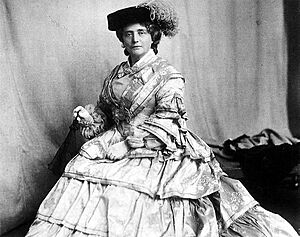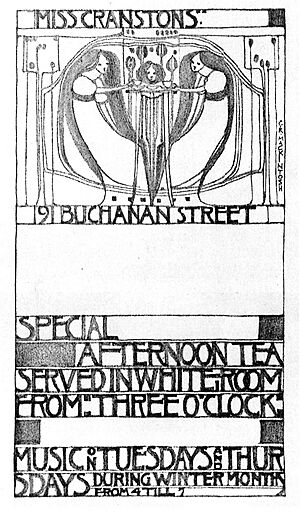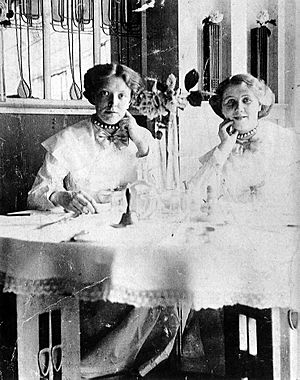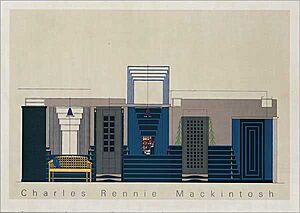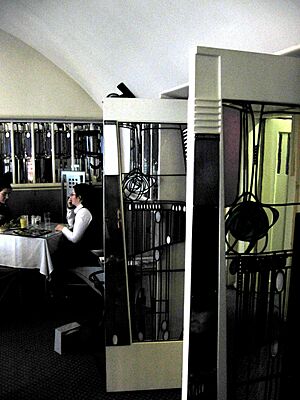Catherine Cranston facts for kids
Catherine Cranston (born May 27, 1849 – died April 18, 1934), often known as Kate Cranston or Miss Cranston, was a very important person in creating modern tea rooms. She is best known today for supporting famous artists Charles Rennie Mackintosh and Margaret Macdonald Mackintosh in Glasgow, Scotland. Her "Miss Cranston's Tea Rooms" are still remembered as a special part of Glasgow's past.
The Story of Kate Cranston's Tea Rooms
Early Life and Family Business
Kate Cranston's father, George Cranston, was a baker. In 1849, the year Kate was born, he owned a hotel in Glasgow called "Cranston's Hotel and Dining Rooms." This hotel offered comfortable rooms and good food.
Kate's older brother, Stuart, became a tea dealer. He was one of the first to open simple "tea shops" in Glasgow. By 1901, he had three shops that mainly sold tea and sandwiches. Kate, however, wanted to create something much more special for people to gather.
Why Tea Rooms Became Popular
At that time, many people wanted alternatives to pubs, especially for women. Tea used to be a luxury, but by the 1830s, it became popular as a drink instead of alcohol. Many new cafes and coffee houses opened for everyone. But it wasn't until the 1880s that tea rooms became truly fashionable.
Opening Her First Tea Rooms
In 1878, Miss Kate Cranston opened her first tea room, the Crown Luncheon Room, on Argyle Street, Glasgow. She insisted on excellent service, delicious food, and perfect cleanliness. Her big idea was to create a social place that was more than just a restaurant. She also paid great attention to making these places look beautiful and modern. Her first tea room had a traditional Scottish design.
In 1886, she opened her Ingram Street tea room. In 1888, she asked artist George Henry Walton to decorate a new smoking room in the Arts and Crafts style.
In 1892, Kate married John Cochrane. But she continued to run her businesses under the name "Miss Cranston's Tearooms." She opened new tea rooms in Buchanan Street in 1897. She expanded her Argyle Street location in 1898. Finally, she opened her most famous tea room, the Willow Tearooms, in Sauchiehall Street in 1903. This one was designed by Charles Rennie Mackintosh.
A New Kind of Social Place
While other cities had very expensive or very basic tea rooms, Kate Cranston set a new standard in Glasgow. Her tea rooms were welcoming and comfortable. She had special rooms just for ladies and others just for gentlemen. There were also luncheon rooms where everyone could eat together. Gentlemen could also use smoking rooms and billiards rooms.
"Miss Cranston's Tea Rooms" became popular meeting spots for everyone. Businessmen, apprentices, ladies, and their maids all visited. The "Ladies Rooms" were especially successful. They allowed respectable women to meet and socialize without needing male company. Unlike other cafes, there was no strict supervision. Guests could choose from a variety of scones and cakes. A small sign reminded them to remember what they had eaten. Paying was simple: you told the attendant what you had, received a check, and paid at the desk.
Glasgow was a center for art at this time. The tea rooms often displayed paintings by the "Glasgow Boys" artists. A famous architect, Sir Edwin Lutyens, visited the Buchanan Street tea room in 1898. He described Kate Cranston as "a dark, fat wee body with black sparkling luminous eyes." He noted that she had become rich by offering good, clean food in beautiful, artistic surroundings.
People from other cities noticed Glasgow's tea rooms. In 1901, it was said that Glasgow was like "Tokio for tea-rooms." You could get a lot for a little money, and these places were very popular. It was even said that the lack of tea shops made Glasgow people feel far from home when they were in London. The original Willow Tearooms building was restored and reopened in 2018.
Working with George Walton and Charles Rennie Mackintosh
George Henry Walton started his decorating business after Kate Cranston hired him in 1888. In 1896, she asked him to design the inside of her new Buchanan Street tea rooms. These opened in 1897. Charles Rennie Mackintosh helped Walton. Mackintosh designed beautiful wall murals for the ladies' tea room, the luncheon room, and the smokers' gallery. These murals featured tall female figures surrounded by roses.
People in Glasgow loved these designs. They even made up a new saying: "It's quite Kate Cranston-ish!" This meant something was extremely beautiful.
Kate Cranston expanded her Argyle Street tea room in 1898. She asked Walton to create a more modern interior. He designed fireplaces, wall murals, and stained glass panels for the doors. The luncheon room had a rose pattern theme. Mackintosh designed the furniture, including his famous high-backed chairs.
In 1900, Kate Cranston gave Mackintosh a chance to design an entire room at the Ingram Street tea room. He had just married the artist Margaret Macdonald Mackintosh. Together, they created the "White Dining Room." This room had a special hallway with wooden screens and leaded glass panels. These panels allowed people to peek into the room as they entered. Mackintosh's fame grew. In 1902, a magazine called The Studio wrote that his tea rooms were "one of the sights of the city."
The Willow Tearooms: A Masterpiece
Kate Cranston then gave Mackintosh his biggest project: designing an entire building on Sauchiehall Street. Again, he worked with his wife, Margaret MacDonald, on the interior designs. The building had a simple but striking outside. Inside, there were three main tea rooms on the ground floor and a first-floor gallery. Steps led up to the famous "Room de Luxe." This special room stretched across the front of the building.
A humorous review in the Glasgow Evening News described the "Room de Looks" (Room de Luxe). It said the chairs were unlike any others, but you could tell they were chairs. It also mentioned the mirrors with "purple leeks" painted on them.
In 1905, a German magazine called Dekorative Kunst featured the Willow Tea Rooms. It said that visitors to Glasgow could "rest body and soul" in Miss Cranston's Tea Rooms. For a few pennies, they could drink tea, have breakfast, and "dream that he is in fairy land."
More Projects and Later Years
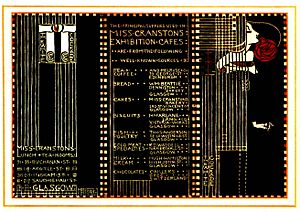
Even after the Willow Tearooms, Kate Cranston continued to work on new projects. Mackintosh kept creating amazing designs for her. In 1904, she asked him to redecorate her home, Hous'hill, near Nitshill.
Mackintosh also worked on the Argyle Street tea room again in 1906. He designed a basement area called The Dutch Kitchen. In 1911, he redesigned rooms in the Ingram Street tea rooms, creating the Cloister Room and the Chinese Room. The Chinese Room was very exotic, with bright blue screens and dark blue furniture. It was Mackintosh's unique take on an oriental style.
In the same year, Kate Cranston set up temporary "Exhibition Cafes" at the Scottish International Exhibition. Charles Rennie Mackintosh likely designed these. The menu card, designed by Margaret Macdonald Mackintosh, showed the name "The White Cockade." It also credited "Miss Cranstons Bakery" for supplying cakes.
In 1916, Kate opened Cranston's Cinema De Luxe. This was part of a large entertainment complex designed by architect James Miller.
In 1917, Mackintosh did his last work for Kate Cranston. He designed an extension for the Willow Tea Rooms called The Dug Out. This design had a modern style that looked ahead to the Art Deco movement.
Kate Cranston was very sad when her husband died in 1917. After his death, she sold her tea rooms and other businesses. She retired from public life. She had no children. When she died in 1934, she left most of her money to help the poor people of Glasgow.
Kate Cranston's Lasting Impact
Even after Kate Cranston sold her businesses, the name "Miss Cranston's Tea Rooms" remained famous. It was a symbol of quality and a reminder of Glasgow's golden age. By 1938, some tea rooms were still run by "Cranston's Tea Rooms Ltd." However, they closed down in 1954.
The Willow Tearooms building was sold to a department store in 1928. The store kept the Room de Luxe open as its own tea room.
The "Miss Cranston's Tearooms" on Ingram Street were used as catering facilities for many years. In 1950, Glasgow City Council took ownership. The original furnishings were removed and stored in 1971 when the building was torn down. These are now the only original Mackintosh tea room interiors that still exist. Restoration work began in 1993. The "Ladies' Luncheon Room" was displayed three years later. The "Chinese Room" and "Cloister Room" have also been restored. There are plans to display some of these interiors at the new V&A museum in Dundee. The "Oak Room," designed by Charles Rennie Mackintosh, was conserved for the V&A Museum of Design in Dundee.
Mackintosh's fame faded for a while, but he was later recognized as a pioneer of modern architecture. His work on the outside of the Willow Tea Rooms was especially important. In the 1960s, interest in Art Nouveau brought him international fame. The furniture and designs he and his wife created for Kate Cranston are now extremely valuable.
When the department store closed, the Willow Tea Rooms were restored to look like they did originally. The Room de Luxe reopened for tea. A new tea room also opened on Buchanan Street, near Kate Cranston's original locations. This new tea room has copies of the White Dining Room and Chinese Room designs.
In 2017, a legal issue about the "Willow Tea Rooms" name was solved. The Buchanan Street location now uses the name "The Willow Tea Rooms." These new tea rooms highlight how much Kate Cranston's support helped Mackintosh's work. Her impact on Glasgow's social life is still remembered in books like Tea at Miss Cranston's. The original Willow Tea Rooms building reopened in 2018. It now has a large visitor center next door.
The continued interest in Miss Cranston is also seen in the high prices paid for items from her tea rooms. For example, six pieces of cutlery stamped "Miss Cranston's" sold for £940.
In October 2018, it was announced that Kate Cranston would be featured on a new The Royal Bank of Scotland £20 note in 2020. She is the first woman other than Queen Elizabeth II to appear on a £20 banknote in Scotland.
|


